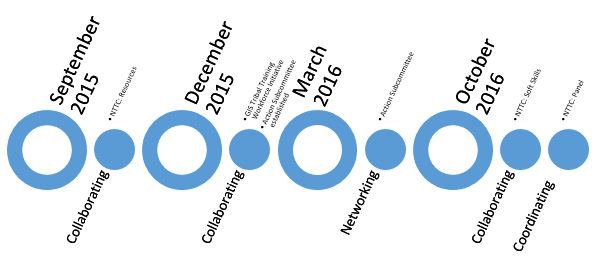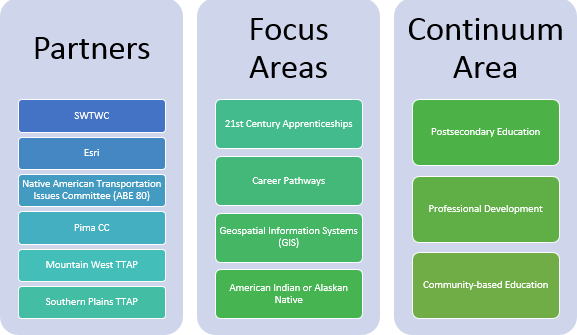General goals
In a collaborating partnership with Esri, SWTWC will form a GIS Tribal Training Workforce Initiative to advocate the development of GIS tribal training programs, and the use of geographic information systems (GIS) within tribal populations.
Status: Ongoing
Anticipated Partnership Duration: September 2015 – Center Lifetime
Timeline and Overview

Building on the success of SWTWC Associate Director Tyler Reeb as a speaker at the 2015 National Tribal Training Conference (NTTC) where Reeb identified a gap in the transportation workforce especially in tribal communities, Reeb developed the Center’s GIS Tribal Training Workforce Initiative. This Initiative is dedicated to the creation of career pipelines to enter the transportation workforce within and beyond tribal reservations with emphasis on underserved tribal populations.
In addition, the Workforce Initiative will enable tribal communities to utilize GIS to capture better data about road safety, transportation, and a range of other critical community metrics on respective reservations, and in turn, seek state funding and workplace development for the tribal community.
In order to better understand tribal population needs in terms of transportation workforce development, Reeb has attended, presented, and moderated panels at NTTC for 2015 and 2016. At the time of this document’s submission, SWTWC is developing a GIS panel presentation for the 2017 Transportation Research Board (TRB) Board’s Native American Transportation Issues Committee (ABE 80).
For various GIS workforce development efforts and panels, Reeb has coordinated a collaborating partnership with the following representatives:
- Terry Bills from Esri and SWTWC Steering Committee;
- Garet Couch from Tribal GIS;
- Ron Hall from Bubar & Hall Consulting and TRB Native American Transportation Issues Committee;
- Pamela Jurney from South Central Arc Users Group and GIS Professional; and
- Karla Sisco from Southern Plains TTAP and SWTWC Steering Committee.
In the presentations and panels, Reeb highlighted programs, resources, and various models tribal communities may implement or utilize for GIS-related transportation workforce development. In 2017, SWTWC plans to further the initiative by developing apprenticeships and internships for GIS training with emphasis on tribal communities and the specific population transportation needs.
Key Deliverables
- SWTWC Workforce Initiative: GIS Tribal Training
- 2015 NTTC Conference: Presentation titled “National and Regional Resources for TTAPs”
- 2016 NTTC Conference: Presentation titled “Workplace Competencies”
- 2016 NTTC Conference: Panel titled “GIS – Funding and Workplace Development: How GIS Technology Can Help Tribal Communities Capture Data, Secure Funding, and Promote Workplace Development”
- 2017 Transportation Research Board (TRB) Panel: Panel titled “GIS – Funding and Workplace Development: How GIS Technology Can Help Tribal Communities Capture Data, Secure Funding, and Promote Workplace Development”
Anticipated outcomes
Through a range of collaborating partnerships supporting the GIS Training Initiative, SWTWC anticipates that a well-trained GIS workforce, particularly in tribal communities, will emerge from this Workforce Initiative. The GIS tribal workforce will be able to gather and process relevant geospatial data pertaining to the transportation needs of their communities, and seek government funding for infrastructure and workplace development in local tribal areas. Furthermore, with the GIS training, tribal community members will have increased career opportunities in the Southwest region; including transportation careers outside the reservation, and increase the transportation labor market pool.
To assess the success of the GIS Initiative, SWTWC will expand the partnership to include relevant transportation stakeholders, and document all industry outreach efforts to promote the Initiative. SWTWC will also follow-up with agencies involved in GIS and tribal communities, and analyze the GIS workforce trends through the Center’s lifetime.
In 2017, SWTWC will forge partnerships between stakeholders in academia and industry to develop apprenticeship and internship programs.
Contribution Analysis
- SWTWC Associate Director Tyler Reeb presented at the 2015 NTTC.
- SWTWC developed the GIS Training Workforce Initiative.
- SWTWC Associate Director Tyler Reeb hosted a panel at the 2016 NTTC.
- SWTWC Associate Director Tyler Reeb presented at the 2016 NTTC.
- SWTWC Associate Director Tyler Reeb will be hosting a GIS panel at 2017 TRB Annual Meeting.
- SWTWC Associate Director will participate in the 2017 NTTC.
Documentation
Reeb, T. (October 2016). “GIS = Funding and Workforce Development: How GIS Technology Can Help Tribal Communities Capture Data, Secure Federal Funding, and Promote Workforce Development.” Retrieved from http://nttc.nijc.org/wp-content/uploads/2014/10/REEB-TRUSTY.pdf
SWTWC. (2016). “GIS = Funding and workforce development: How GIS technology can help tribal communities capture data, secure federal funding, and promote workforce development.” Retrieved from https://www.swtwc.org/wp-content/uploads/2016/12/NTTC2016GIS-panel.pdf.
SWTWC. (2016). “Workforce competencies.” Retrieved from https://www.swtwc.org/wp-content/uploads/2016/12/Workforce-Competencies-10.4.2016-1.pdf.
SWTWC. (2015). “National and regional resources for TTAP.” Retrieved from https://www.swtwc.org/wp-content/uploads/2016/12/National-and-Regional-Resources-for-TTAPs.pdf.
